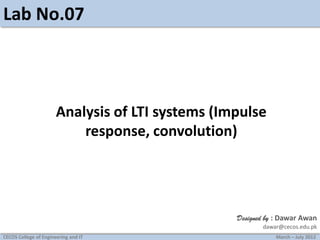
LTI Systems Analysis Impulse Response Convolution
- 1. Lab No.07 Analysis of LTI systems (Impulse response, convolution) Designed by : Dawar Awan dawar@cecos.edu.pk CECOS College of Engineering and IT March – July 2012
- 2. LTI systems Systems that are both linear and time invariant are called LTI systems. The behavior of LTI systems is completely characterized by their impulse response. The input and output of an LTI system is related by convolution sum/integral. CECOS College of Engineering and IT March – July 2012
- 3. Impulse response Impulse response ‘ h[n] ’, is the output of an LTI system, when the input is a unit impulse. Given the impulse response, we can find the output for any input using convolution. CECOS College of Engineering and IT March – July 2012
- 4. Difference equation A very common representation of LTI systems is in the form of difference equation The general difference equation is K=M K=N K=0 K=0 ∑ ak y[n-k] = ∑ bk x[n-k] example : for , y[n] – 5/6y[n-1] + 1/6y[n-2] = 1/3x[n-1] a0=1, a1=-5/6, a2=1/6, CECOS College of Engineering and IT and bo=0, b1=1/3 March – July 2012
- 5. Impulse response Plot the impulse response of the following difference equation . y[n] – 5/6y[n-1] + 1/6y[n-2] = 1/3x[n-1] CECOS College of Engineering and IT March – July 2012
- 6. Impulse response CECOS College of Engineering and IT March – July 2012
- 7. Practice 1- Plot the impulse response of the following systems I. y[n] = x[n] + y[n-1] (Accumulator) II. y[n] – y[n-1] = 1/7 (x[n] + x[n-1] + x[n-2] + x[n-3] + x[n-4] + x[n-5] + x[n-6]) (Moving average system)
- 8. Convolution y[n] = x[n] * h[n] = here y[n] is the output signal, x[n] is the input signal, and h[n] is the impulse response of the LTI system. in MATLAB use the instruction ‘ y=conv(x,h) ‘ to perform convolution. CECOS College of Engineering and IT March – July 2012
- 9. Convolution Convolve the following two sequences in MATLAB. CECOS College of Engineering and IT March – July 2012
- 10. Convolution CECOS College of Engineering and IT March – July 2012
- 11. Convolution NOTE MATLAB assumes that both the convolving signals are starting from zero index, hence the time/sample no. of the output signal is not correct always. You have to adjust the time axis of the output signal keeping in view some rules related to convolution. CECOS College of Engineering and IT March – July 2012
- 12. Convolution Hint : length of y = length of (x) + length of (h) - 1 and the starting index for y will be the sum of starting indices of x and h CECOS College of Engineering and IT March – July 2012
- 13. Convolution (without time adjustment) * = CECOS College of Engineering and IT March – July 2012
- 14. Convolution (after adjusting time) * = CECOS College of Engineering and IT March – July 2012
- 15. Task 1- Convolution is associative. Given the three signals x1[n], x2[n], and x3[n] as: x1= [ 3,1,1] x2= [ 4,2,1] x3= [ 3,2,1,2,3] Show that (x1*x2)*x3 = x1*(x2*x3) 2- Convolution is commutative. Given x and as: x=[1,3,2,1] h=[1,1,2] Show that x* h = h*x 3- Determine the output of the LTI system with: h[n] = 2δ[n] + δ[n‐1] + 2δ[n‐2] + 4δ[n‐3] + 3δ[n‐4] x[n] = δ[n] + 4δ[n‐1] +3δ[n‐2] + 2δ[n‐3] CECOS College of Engineering and IT March – July 2012
- 16. Task 4- Convolve the signal x=[1,2,3,4,5,6] with an impulse delayed by two samples. Plot the original signal and the result of convolution. 5- Find the output signal y[n] for any range of ‘n’ using convolution, for the following cases. a) h[n] = 5(-1/2)n u[n] b) h[n] = (0.5)2n u[-n] c) h[n] = 2n u[-n-1] CECOS College of Engineering and IT , , , x[n] = (1/3)n u[n] x[n] = u[n] x[n] = u[n] – u[n - 10] March – July 2012
